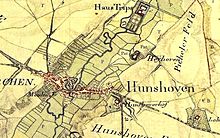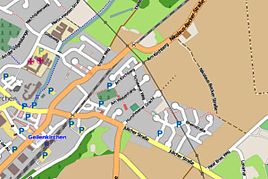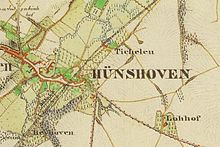Hünshoven
|
Hünshoven
City of Geilenkirchen
Coordinates: 50 ° 57 ′ 47 " N , 6 ° 7 ′ 29" E
|
|
|---|---|
| Height : | 85 (71-98) m |
| Residents : | 4000 (Nov. 30, 2012) |
| Postal code : | 52511 |
| Area code : | 02451 |
|
Location of Hünshoven in Geilenkirchen
|
|
|
House Basten (oil mill) in Hünshoven
|
|

Hünshoven is a district of the medium- sized town Geilenkirchen in the Heinsberg district in North Rhine-Westphalia .
geography
location
Hünshoven is located on the south-eastern edge of Geilenkirchen, on a terrace slope falling towards the Wurm valley . The federal highway 56 and the federal highway 221 run as a common, southwest bypass around the urban area of Hünshoven, Geilenkirchen and Bauchem and continue as individual streets from Am Weißenhaus or Bergerhof . The worm separated the formerly independent villages of Geilenkirchen and Hünshoven.
Neighboring places
| Geilenkirchen | Tripsrath | Süggerath |
| Nierstrass |

|
Bumpers |
| Teveren | Frelenberg | Waurichen |
Type of settlement
Hünshoven was originally a street village with buildings on both sides . The place grew together with the neighboring Geilenkirchen city center in the 20th century . The building structure of the place shows a mixture of residential and commercial buildings, interspersed with markets and medium-sized industrial companies .
history
Place name
- 1212 Hunshovin
- 1217 Hünshoven
- 1300 Hunshoven
- 1457 Hunshoeven
- 1533 Huntzhoven
- 1666 Hunßhoven
- 1820 Hunshoven
Local history
Hünshoven used to belong to the Jülich office of Geilenkirchen. In 1217, the patronage of the Church of St. Johannes Baptist was transferred by Dietrich von Heinsberg to the Premonstratensian order , which also held the tithe . The papal confirmation of 1225 mentions a court that was probably identical to the Hünshoven court. 1457 another court appeared to Hünshoven as Heinsberger fief , who later became the man chamber was under Geilenkirchen. After the First World War, the Rhineland was demilitarized and occupied by Allied troops; In Geilenkirchen there were French, Moroccan and Belgian troops (Morocco had been a French protectorate since 1912). From 1918 to 1929 Belgian occupation soldiers were stationed in a barracks (Kamp van Dinant), which was south of the Hünshoverner Hof on Aachener Straße. In 1828 Hünshoven had a total of 612 inhabitants. Numerous important institutions of the city of Geilenkirchen are located in the area of the district of Hünshoven, such as the Geilenkirchen train station , the main office of the Kreissparkasse, the district craftsmen, the main offices of WestEnergie and WestVerkehr as well as the Gerberkarree with the pedestrian zone.
Catholic Church History
The parish of St. Johannes Baptist consists of the towns of Hünshoven with Hommerschen, Jakobshäuschen, Loherhof, Marienhof, Muthagen, Tichelen, Breill Castle and Trips Castle . The majority of the population consists of Catholics .
The beginning of a parish in Hünshoven is not known. The first church will have been the estate's own church , which later passed to the Lords of Heinsberg . In 1217 the patronage of the Johannes Baptist Church was transferred to the Premonstratensian Order by Dietrich von Heinsberg. In 1804, Bishop Berdolet assigned the parish to the canton of Geilenkirchen. In 1808 the parish lost its independence and was combined with the Geilenkirchen parish of St. Mary's Assumption to form a parish. On August 15, 1844, Archbishop Johannes von Geissel (1796–1864) gave the parish its rights and property again.
In the course of the parish reforms in the Diocese of Aachen , the formerly independent, Catholic parish of St. Johannes Baptist was incorporated into the Community of Parishes (GdG) St. Bonifatius Geilenkirchen .
Evangelical parish
The Protestant parish of Geilenkirchen-Hünshoven has around 4500 members. The environment is mostly Roman Catholic. But since the late 16th century a self-confident Protestant community has developed in Geilenkirchen (today the district of Heinsberg), which has grown immensely , especially due to the refugees after the Second World War . This growth in the number of parishioners led to the establishment of a second pastorate in 1993 . Since then there have been two pastoral care districts.
The first district comprises the north of the urban area with Bauchem and the villages of Gillrath , Nierstraß , Tripsrath , Niederheid , Hochheid , Süggerath and Prummer .
The second district includes the south of the city of Geilenkirchen with the city center, Hünshoven and the villages of Teveren , Grotenrath , Immendorf , Waurichen and Apweiler .
The centers of community life are the two listed churches with attached community centers in Geilenkirchen and Teveren. In Geilenkirchen there is also the community office, the Zille youth center and the Protestant cemetery . There is also a small Protestant cemetery in Grotenrath.
politics
Hünshoven forms a district with Geilenkirchen and Bauchem. The municipality is represented by a mayor on the city council.
Attractions
- Catholic parish church St. Johannes Baptist in Hünshoven as monument no.32
- Stained glass of the Catholic parish church in Hünshoven
- Evangelical parish church in Hünshoven as monument no.28
- Stained glazing of the Evang. Parish church Hünshoven
- Evangelical parish office in Hünshoven as monument no.29
- Gut Muthagen near Hünshoven as monument no.39
- House Basten (oil mill) in Hünshoven as monument no.15
- Former pharmacy in Hünshoven as monument no.30
- Triumphal cross in front of the cemetery in Hünshoven as monument no.54
- Hünshovener Hof in Hünshoven as monument no.66
- Pavilion in Loherhof near Hünshoven as monument no.10
- Breill Castle near Hünshoven as monument no.2
Infrastructure
- In Hünshoven there are several farms and manors , a gardening shop and also a number of commercial enterprises , handicraft businesses , service companies , shops, offices, markets and several small businesses.
- The AVV bus lines GK1, SB1, SB3, 71, 407, 410, 431, 432, 434, 435, 437, 491, and 494 of the AVV converge at the bus station on the station forecourt in Hünshoven .
- A total of three playgrounds have been set up in Hünshoven on An St. Johann, Konrad-Adenauer-Straße and Ruhrstraße.
- The Deutsche Bahn (DB) railway line runs through Hünshoven with the regional railway lineRE 4 Wupper-Express Aachen - Mönchengladbach - Düsseldorf - Dortmund ,RB 20 Euregiobahn Aachen - Geilenkirchen and the regional train lineRB 33 Rhein-Niers-Bahn Aachen - Mönchengladbach - Krefeld - Duisburg
- The place has a connection to the cycling network NRW .
societies
- St. Johannes Schützenbruderschaft Hünshoven eV from 1663.
- St. Johannes Schützenkapelle Hünshoven eV
- FSV (Football Sports Association) 09 Geilenkirchen-Hünshoven eV
- Hünshoven church choir from 1857.
- Catholic women's community in Germany kfd from 1978.
- Young Choir Hünshoven
- Children's choir Hünshovener Spatzen
Regular events
- Birdshot of the Brotherhood of St. John
- Patronage festival and fair in Hünshoven
- Pentecost market, folk festival with fireworks
- St. Martin parade in Hünshoven
Personalities
Born in Hünshoven
- Ludolf Camphausen (1803–1890), banker, Prussian Prime Minister in the revolutionary year of 1848
- Otto von Camphausen (1812–1896), Prussian Finance Minister
- Max Wilms (1867–1918), German doctor and surgeon
Connected to the city
- Nikolaus Becker (1809–1845, October 8, 1809 in Bonn; † August 28, 1845 in Hünshoven,), clerk at the peace court and writer; Poet of the Rhine song
literature
- Handbook of the Diocese of Aachen. 3rd edition. Kühlen, Mönchengladbach 1994, ISBN 3-87448-172-7 , pp. 707-709.
- Leo Gillessen: The localities of the district of Heinsberg. Heinsberg 1993, ISBN 3-925620-13-3 , p. 125.
- Friedrich von Restorff : Topographical-statistical description of the Royal Prussian Rhine Province. Nicolai, Berlin / Stettin 1830, OCLC 165725051 .
Web links
- Website of the city of Geilenkirchen
- Monuments in the city of Geilenkirchen
- Churches and chapels in the city of Geilenkirchen
- Evangelical Church in Hünshoven
Individual evidence
- ^ German basic map 1: 5000
- ↑ geilenkirchen.de
- ↑ Archive link ( Memento of the original from June 9, 2016 in the Internet Archive ) Info: The archive link was inserted automatically and has not yet been checked. Please check the original and archive link according to the instructions and then remove this notice. Main statute of the city of Geilenkirchen
- ↑ glasmalerei-ev.net
- ↑ glasmalerei-ev.net











